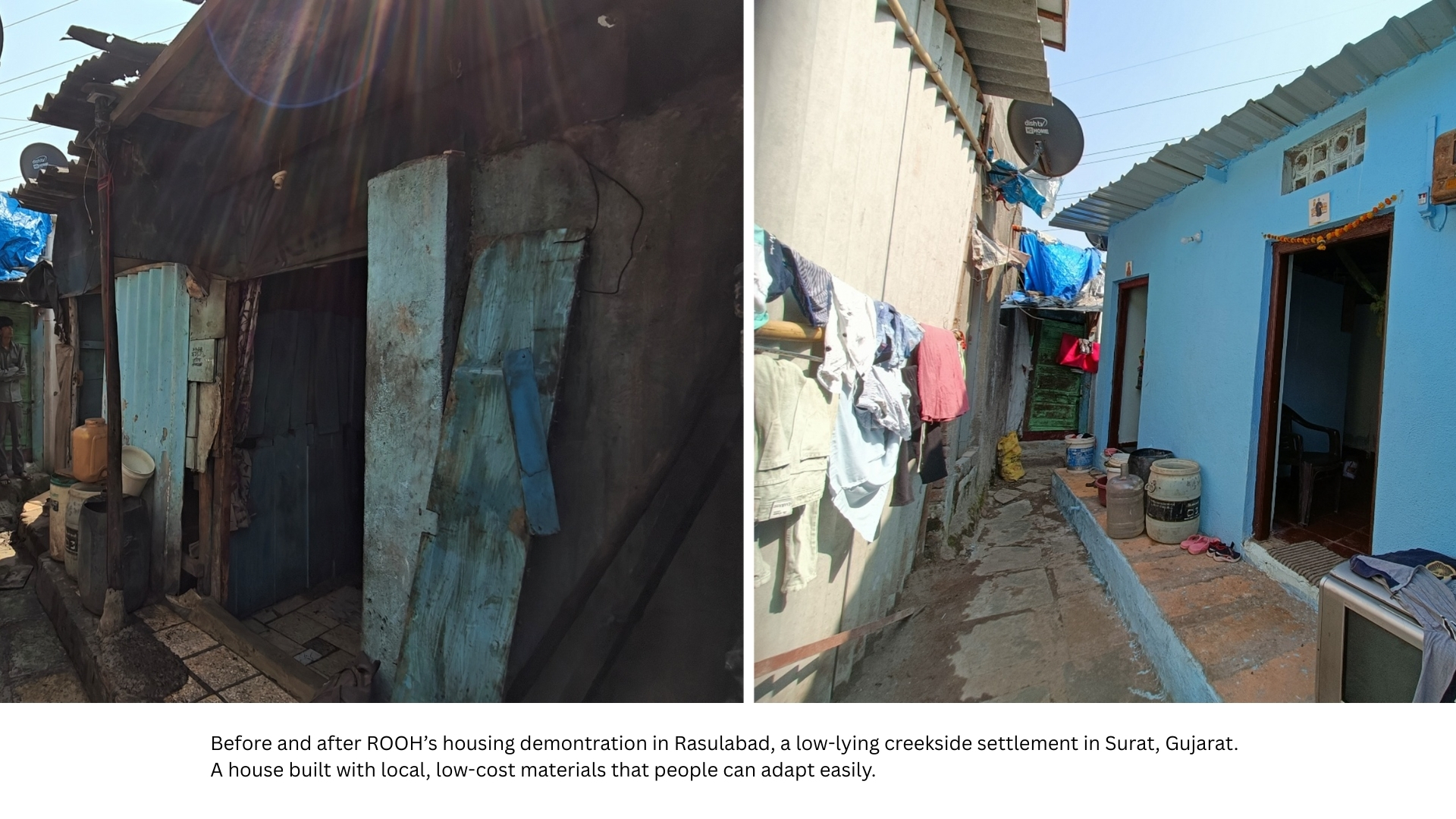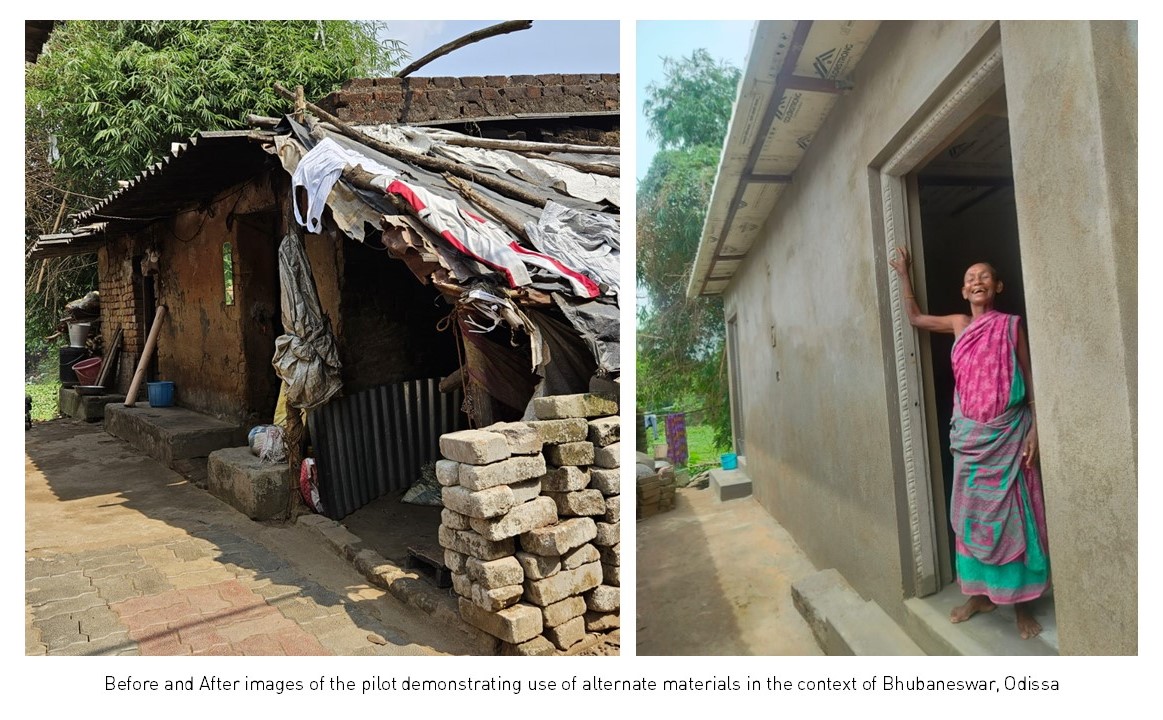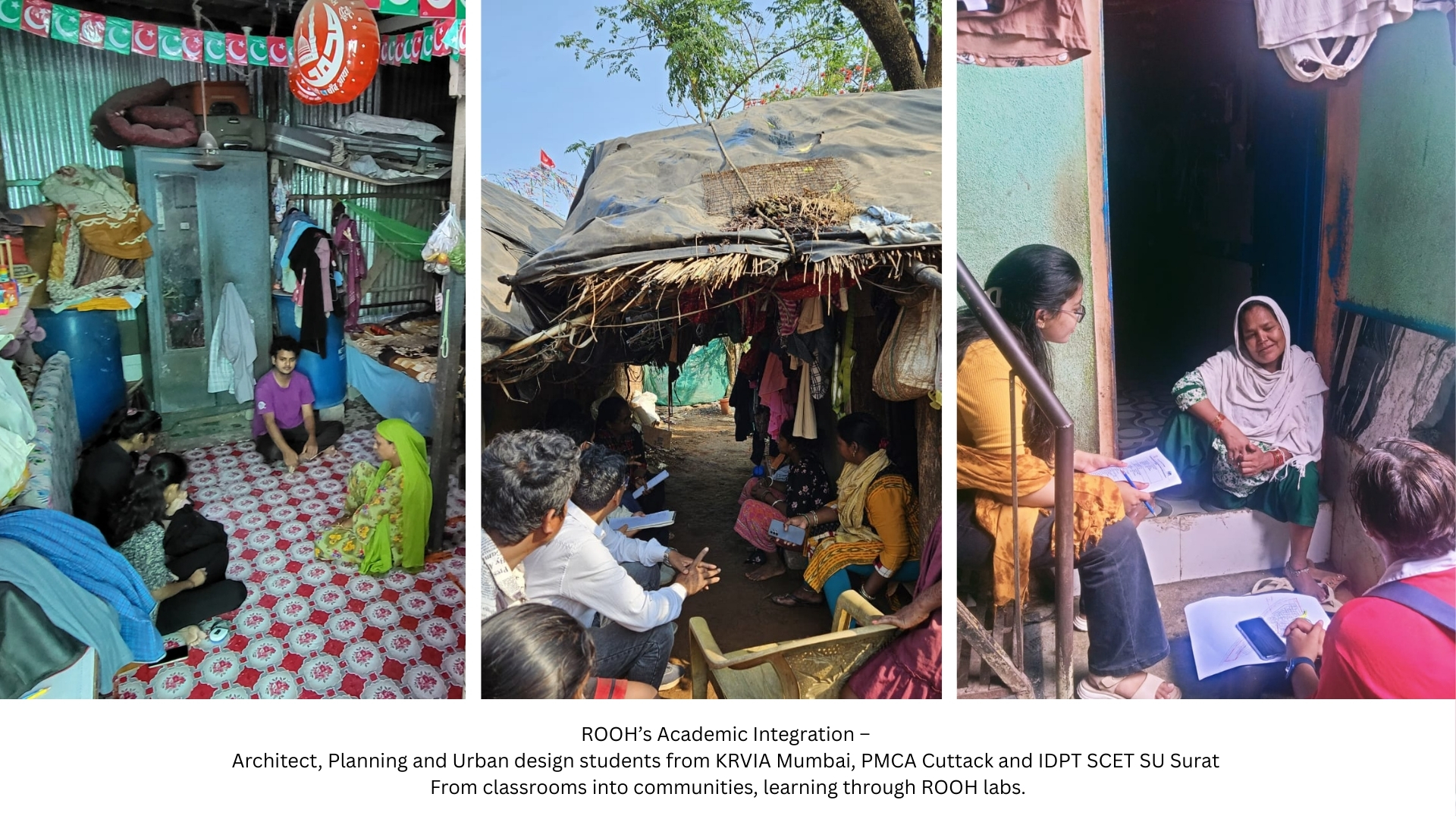Women Lead the Design of Climate-Resilient Housing
Organization: Society for the Promotion of Area Resource Centers
2025 LOCAL ADAPTATION CHAMPIONS AWARD FINALIST
Across India and the Global South, low-income urban women are driving a housing revolution in the face of increasing heatwaves, floods, and cyclones. The Roof Over Our Heads (ROOH) campaign—anchored by the Society for the Promotion of Area Resource Centers (SPARC)—is transforming climate-vulnerable informal settlements into hubs of dignity, innovation, and resilience.
Launched as part of the UN Race to Resilience campaign, ROOH redefines who builds climate resilience, and how. By working with women’s collectives in informal settlements, ROOH co-develops low-carbon, affordable, and climate-resilient homes.
Affordable, Accessible, and Adaptable Homes
Built with low-cost, temporary materials like tin sheets, tarpaulin, and mud, dwellings in informal settlements are highly exposed to extreme heat, heavy rainfall, floods, and cyclones. Rising temperatures turn tin-roofed homes into heat traps, forcing families to sleep outdoors in dangerous conditions, while intense rains often cause leaky roofs, damp walls, and frequent collapses.
Floodwaters not only damage structures but also destroy household assets, contaminate living spaces, and spread disease. With little or no access to formal housing finance or insurance, families must repeatedly spend scarce savings on makeshift repairs, locking them in cycles of debt and insecurity. For millions in these settlements, climate change has made the home itself—meant to be a place of safety—a frontline of risk.
At the heart of ROOH are community-based Labs, embedded directly within informal settlements. In these spaces, residents identify vulnerabilities, test adaptation materials, co-design upgrades, and monitor outcomes. Each home becomes a site of learning, where solutions are piloted, refined, and scaled through peer-to-peer knowledge sharing.
From solar-reflective coatings in Pimpri in Maharashtra to breathable Vedic plasters in Surat, Gujarat, women adapt solutions based on their lived experience of climate impacts. “Earlier the walls didn’t breathe. Now the house feels cooler,” said one ROOH participant.

ROOH housing upgrades emphasize retrofits and incremental improvements using locally sourced, climate-smart materials such as fly ash bricks, recycled thermocol, and terracotta tiles. Homes are designed to be:
Affordable: Co-financed by residents through savings and non-cash contributions.
Accessible: Tailored to informal housing realities.
Adaptable: Customized for micro-climates, household needs, and community preferences.
Women monitor outcomes using thermo-hygrometers, tracking temperature and humidity in over 150 homes under climate performance monitoring. Early impacts include:
Ceiling fan use reduced from 12 to 2 hours/day.
Up to US$ 25/year saved on temporary tarpaulin materials.
Increased home use for livelihood activities, especially by women.
ROOH is not only improving homes—it is shifting power. Women lead every stage: from choosing materials and negotiating with contractors to hosting planning meetings and aggregating demand.

“We used to sleep outside in the summer. Now, after the upgrades, we host guests. This is no longer just a shelter—it’s a home,” said Anita Sathe, a resident leader from Pimpri.
To overcome barriers in housing finance, ROOH leverages community savings systems, non-cash contributions, and peer networks. Long-standing women-led collectives such as Mahila Milan support transparent fund management and project planning.
Partnerships Driving Scale
ROOH thrives on cross-sector collaboration, bringing together:
Academic partners (like School of Planning and Architecture in New Delhi, UC Berkeley, and Universitas Islamia Indonesia) for research and curricula.
Material innovators & waste pickers (like Chintan and Hasiru Dala) to anchor circular economy solutions.
Local governments (like the Ahmednagar Municipal Council) to integrate ROOH into public housing.
Industry partners (like Holcim and other small and medium enterprises) to co-develop scalable material innovations.
Global platforms (like Global Resilience Partnership and the Global Covenant of Mayors) to connect grassroots learning to policy.
As of 2025, ROOH operates in 36 cities across 10 countries, including India, Indonesia, Egypt, Kenya, and six Latin American nations. With 56 active Labs, each tailored to local risks and materials, ROOH is demonstrating its global adaptability.
In Latin America, 21 Labs and six housing prototypes have been developed with partner TECHO, co-designed with communities facing heatwaves, landslides, floods, and storms.

A Model for Women’s Climate Leadership
ROOH is being recognized internationally as a model for locally led adaptation that centers women’s livelihoods. It breaks barriers by:
Training women in technical construction skills.
Supporting women to negotiate directly with vendors and contractors.
Piloting affordable materials that cut energy and repair costs.
Embedding climate literacy into housing design.
“Resilience is no longer aspirational—it’s already happening. A single upgraded home inspires ten more,” said Sheela Patel, Director of SPARC and Global Ambassador for ROOH.
Looking Ahead
By 2050, ROOH aims to reach two billion people as part of the Race to Resilience. Its immediate priorities include:
Launching 100 new Labs across Asia and Africa.
Replication in at least five major cities.
Doubling climate-resilient housing units in informal settlements.
Developing global tools—a materials directory, vendor playbook, and resilience index.
Mainstreaming resilient housing into architecture schools and public policy.
ROOH proves that resilience is not a privilege—it is a right. And it shows that low-income women are not just participants in climate action—they are its architects, strategists, and champions.